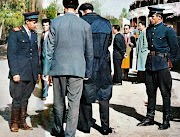Durres Liberated: A Step Towards Albanian Self-Determination
Albanian Chronicles Diary
November 14, 1944
The liberation of Durres on November 14, 1944, holds considerable significance in Albanian history and, more broadly, in the resistance movements across the Balkans during World War II. This event marked not only the removal of the Nazi grip, which had brutally subjugated the country, but also a powerful symbol of rebirth and popular will. The date marks a pivotal shift: on the one hand, it ended German occupation on Albanian soil; on the other, it opened a new chapter for the nation’s political and social future, bringing closer the long-held dream of an independent, self-determined Albania.
Monument to the Martyrs of Liberation in Durres
This monument in Durres, with the inscription “Lavdi Dëshmorëve” ("Glory to the Martyrs"), honors the Albanian fighters who fell during World War II. The site commemorates the sacrifice of those who fought for freedom, representing a symbol of patriotism and resistance for the entire nation.
Historical Context and Tensions
To fully grasp the significance of Durres' liberation, it’s essential to place the event within the broader context of wartime developments and social unrest. Beginning in September 1943, with Italy’s armistice with the Allies, Albania quickly fell under German control. The Italian surrender brought a profound change in the occupation’s structure, with the Germans seizing critical strategic points, aware of Albania’s geographical vulnerability: its Adriatic coastline provided a crucial link between Europe and the Balkan and Mediterranean fronts.
German control was marked by a repressive and violent policy aimed at crushing any attempts at rebellion, in a context where the Albanian people were already suffering economically and socially. The Albanian resistance, organized around the National Liberation Movement (Lëvizja Nacional-Çlirimtare), intensified its operations, becoming increasingly coordinated and structured. Supported by partisans across the territory and led by a determined leadership, this movement launched attacks to destabilize the occupiers and strike critical Nazi infrastructure, including transportation and communication lines. The local population’s support proved vital, with thousands of civilians offering logistical support, information, and resources to the partisans.
The Strategic Importance of Liberating Durres
Durres, due to its strategic location and economic role, was one of Albania’s main ports and a highly strategic target. Nazi control of the port provided a logistical stronghold for military supplies and troop movements. As the Albanian partisans advanced and consolidated their positions, the liberation of Durres became a priority. Capturing Durres meant depriving the German army of a critical logistical resource and clearing the way to the capital, Tirana, which would be liberated just days later, on November 17, 1944.
The liberation operations, driven by the partisans’ tenacity and determination, culminated in a victory that dealt a decisive blow to the Nazi presence in Albania. Taking the city shifted the balance of power and accelerated the country’s liberation. This triumph was not merely the result of a well-coordinated military strategy but also of relentless collaboration among various resistance factions, which put aside political differences to unite in the struggle for freedom.
The Role of the "Antonio Gramsci" Battalion
Among the key forces in the liberation of Durres was the "Antonio Gramsci" Battalion, composed of former Italian soldiers who, following the 1943 armistice, chose to join the Albanian partisan fight rather than return to Italy. The battalion, consisting of men who had experienced betrayal by their own commanders and the hardships of war and occupation firsthand, saw the Albanian liberation struggle as a means of redemption and a fight against both Fascist and Nazi oppression. Named in honor of Italian philosopher and political leader Antonio Gramsci for his opposition to Fascism, the battalion was renowned for its courage and determination, earning the respect of Albanian partisans and the local population alike.
The Gramsci battalion actively participated in numerous operations and played a pivotal role in the successful liberation of Durres. Their presence represented an alliance and solidarity that transcended national borders, sending a vital signal to a population that, despite years of oppression and suffering, was now beginning to glimpse the prospect of freedom.
The Significance of Durres' Liberation
The liberation of Durres held deep meaning not only for Albania but also for the broader geopolitical landscape of the Balkans. It symbolized the Albanian people's determination and the success of their resistance against a superior military force. This event also reinforced nationalist sentiment, consolidating Albanian identity at a time when the country was preparing to embark on its path toward reconstruction and self-determination.
Moreover, freeing this port city fostered a collective awareness of the importance of national sovereignty and freedom from foreign influence—ideals that would become deeply rooted in Albanian mentality and culture over the ensuing decades. The resonance of this event spread to neighboring countries, where other resistance movements drew inspiration from the Albanian struggle, viewing it as an example of how a small nation could resist and ultimately triumph against a relentless occupation.
This victory was not merely a territorial gain but a profound affirmation of national dignity and identity. After centuries of Ottoman rule, followed by foreign impositions during the world wars, Albania was finally positioned to choose its destiny. The liberation of Durres thus became a powerful symbol of not only the fight against occupation but also the prospect of a sovereign Albania, free to build a society grounded in its own values and interests.
Sources and Bibliography
1. "Il battaglione 'Gramsci'. I soldati italiani nella lotta antinazifascista in Albania" (ilpensieromediterraneo.it)
2. "Quell’oltraggio in patria agli eroi del Battaglione Gramsci" (patriaindipendente.it)
3. Antonella Fiorio, Quando un’idea resiste alla distruzione. Storia del Battaglione "Antonio Gramsci" in Albania 1943-1944, (istitutodelnastroazzurro.org)

.jpg)








0 Comments